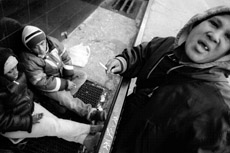
Michael Manning (Cambridge, MA), Lee on the corner, Frances and Churro stay warm on the grate, 2003, From the series "La Familia," gelatin silver print, 12 x 18 inches, Courtesy of and copyright Michael Manning
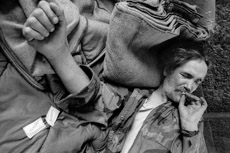
Michael Manning (Cambridge, MA), KC smokes under the bridge, 2003, From the series "La Familia," gelatin silver print, 12 x 18 inches, Courtesy of and copyright Michael Manning
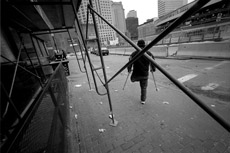
Michael Manning (Cambridge, MA), Freddie, on his way to see Romiro, 2003, From the series "La Familia," gelatin silver print, 12 x 18 inches, Courtesy of and copyright Michael Manning<

Michael Manning (Cambridge, MA), Dennis, 2003, From the series "La Familia," gelatin silver print, 12 x 18 inches, Courtesy of and copyright Michael Manning
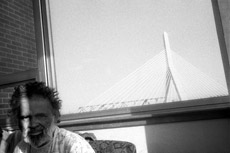
Michael Manning (Cambridge, MA), Romiro, back on the street, 2003, From the series "La Familia," gelatin silver print, 12 x 18 inches, Courtesy of and copyright Michael Manning
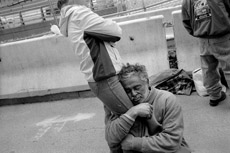
Michael Manning (Cambridge, MA), Romiro at Spaulding Rehab, 2003, From the series "La Familia," gelatin silver print, 12 x 18 inches, Courtesy of and copyright Michael Manning
CURATORIAL STATEMENT
Michael Manning's featured project began in the winter of 2002/2003 with his desire to discover for himself how people were living on Boston’s streets. This family, known to as “La Familia,” continues to look after each other, a true family in every sense of the word. His elegant statement and photoessay speak for themselves. Manning’s project is an insightful, human look into a world we often see in Boston, but sadly is often overlooked. As an apt coda, Lee moved into her first apartment this December.
A Cambridge-based photographer with over 15 years of experience, Manning has been awarded four 1st place awards from the New England Press Association. Originally from New York, Manning attended Nova Scotia College of Art and Design and graduated from the Art Institute of Boston. He has exhibited at the Boston Architectural Center, Fidelity Corporation ( Boston, MA), and the Danforth Museum of Art ( Framingham, MA). A former staff photographer to CNC publications, he has also contributed to the Associated Press, New York Times, Rolling Stone, Boston Magazine, and the Boston Globe, among others. Manning’s other projects include an inside look at a Greek Orthodox Church in Watertown, MA, the festival of Cosmas and Damien in East Cambridge, MA, and an ongoing series on his own family.
ARTIST STATEMENT: La Familia: Life on the Street
This piece began with my desire to find out how the poor economy, and the cuts in social programs, was affecting people living on the streets of Boston in the winter of 2003. It was a loose idea in my mind, I wanted to meet people and see what was going on. Then, on my first day out, I met Lee. She was drunk, tough, and in my face. She wouldn't let me walk toward a group of her friends who had gathered on the corner. They were dancing and singing, snow was falling; they were drinking from paper bags. I wanted to photograph but nothing was going to happen for me in that world without Lee. There was something in the way she was yelling at me, cutting me off, swearing. I understood. She was the mother of this clan, this family of friends, who were living day to day in shelters, under bridges, and on subway grates. I couldn't just walk in and start photographing. Lee was the sentinel, Lee was the bridge, and Lee was big in spirit. That first day she took me in and introduced me to some people. I could take a few pictures. I could come back the next day, maybe around the same time, and go have the free meal at the shelter down the street.
When I came back the next day there was a tension in people. Lee said they had just found out one of the familia, Ramiro, or Papa as she called him, was in the hospital with a serious head injury. He had been missing since Christmas Eve but everyone assumed he was rehabbing again. It turns out he fell backwards, struck a wall at a 45-degree angle, split his head open and suffered serious trauma. They were all on their way to the hospital, on foot, to see him. The day before Lee had said to me, “You know Cheers? Well there are friends and there is familia. Well this is like our Cheers. We take care of each other.” I had no idea that would be so evident so soon. Ramiro, having almost disappeared from the world for good, was now being claimed again as one of the familia. I went with them and began to learn about the real meaning of their friendship.
When we arrived that first day at Spaulding Rehab Ramiro was in bed, had no appetite, and did not seem to remember anyone. He didn't want to walk for the doctors and preferred to sit on the floor. He slid down comfortably. The doctors told the familia that he might never be the same, that his memory might not come back. I could see sadness in their eyes, but it was overcome with empathy and patience. They looked at the 5 staples in his scalp. They asked him where he thought he was and he said, “In church, I owe the Devil some change.” I came back with them to visit Ramiro two more times. They brought him chicken wings to eat (he hated the hospital food), and clothes, and Lee made him a card on the Internet, a floral bouquet get-well card, and printed it out. He seemed to remember more each time. He would ask for other people he hadn't seen in a long time. He was improving. He had also been dry for over 40 days, the longest stretch in his life. On my last visit he told me it would take one minute on the street before he would be drinking again.
In late February, he was released to a transition hospice, where I saw him once. He looked the same, although the vacant look in his eyes was gone. He still had no appetite, but he remembered me, which was a good sign. When they decided he was ready they released him to the street. It seemed there weren't a lot of options since he had no one to live with. When I found him in Chinatown he had been out for several weeks, and was very drunk. He saw me and wrapped me up in his arms and tried to box me and paw me. He told me he loved me. The very last time I saw him he was sitting on the ground, drunk again, hugging a friend around the legs.
